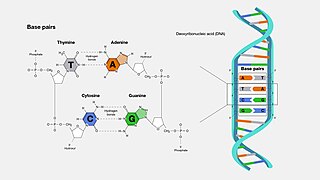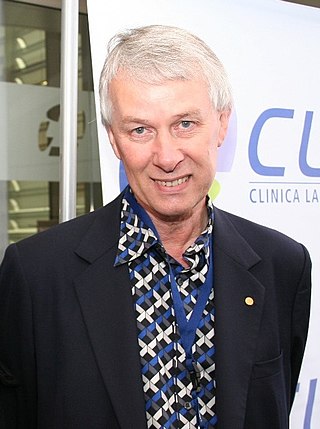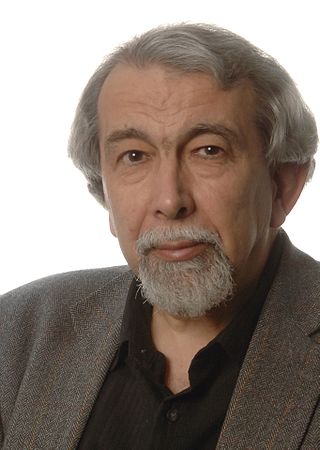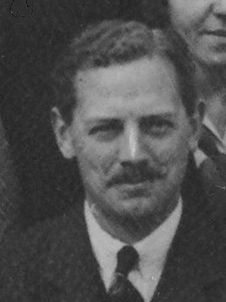Related Research Articles

A base pair (bp) is a fundamental unit of double-stranded nucleic acids consisting of two nucleobases bound to each other by hydrogen bonds. They form the building blocks of the DNA double helix and contribute to the folded structure of both DNA and RNA. Dictated by specific hydrogen bonding patterns, "Watson–Crick" base pairs allow the DNA helix to maintain a regular helical structure that is subtly dependent on its nucleotide sequence. The complementary nature of this based-paired structure provides a redundant copy of the genetic information encoded within each strand of DNA. The regular structure and data redundancy provided by the DNA double helix make DNA well suited to the storage of genetic information, while base-pairing between DNA and incoming nucleotides provides the mechanism through which DNA polymerase replicates DNA and RNA polymerase transcribes DNA into RNA. Many DNA-binding proteins can recognize specific base-pairing patterns that identify particular regulatory regions of genes.
Molecular biology is a branch of biology that seeks to understand the molecular basis of biological activity in and between cells, including biomolecular synthesis, modification, mechanisms, and interactions.

Walter Gilbert is an American biochemist, physicist, molecular biology pioneer, and Nobel laureate.

Jacqueline K. Barton, is an American chemist. She worked as a professor of chemistry at Hunter College (1980–82), and at Columbia University (1983–89) before joining the California Institute of Technology. In 1997 she became the Arthur and Marian Hanisch Memorial Professor of Chemistry and from 2009 to 2019, the Norman Davidson Leadership Chair of the Division of Chemistry and Chemical Engineering at Caltech. She currently is the John G. Kirkwood and Arthur A. Noyes Professor of Chemistry, Emerita.

Sir Richard John Roberts is a British biochemist and molecular biologist. He was awarded the 1993 Nobel Prize in Physiology or Medicine with Phillip Allen Sharp for the discovery of introns in eukaryotic DNA and the mechanism of gene-splicing. He currently works at New England Biolabs.

Sir Gregory Paul Winter is a Nobel Prize-winning English molecular biologist best known for his work on the therapeutic use of monoclonal antibodies. His research career has been based almost entirely at the MRC Laboratory of Molecular Biology and the MRC Centre for Protein Engineering, in Cambridge, England.

Aptamers are oligomers of artificial ssDNA, RNA, XNA, or peptide that bind a specific target molecule, or family of target molecules. They exhibit a range of affinities, with variable levels of off-target binding and are sometimes classified as chemical antibodies. Aptamers and antibodies can be used in many of the same applications, but the nucleic acid-based structure of aptamers, which are mostly oligonucleotides, is very different from the amino acid-based structure of antibodies, which are proteins. This difference can make aptamers a better choice than antibodies for some purposes.

Sir Edwin Mellor Southern is an English Lasker Award-winning molecular biologist, Emeritus Professor of Biochemistry at the University of Oxford and a fellow of Trinity College, Oxford. He is most widely known for the invention of the Southern blot, published in 1975 and now a common laboratory procedure.

Sir Thomas Leon Blundell, is a British biochemist, structural biologist, and science administrator. He was a member of the team of Dorothy Hodgkin that solved in 1969 the first structure of a protein hormone, insulin. Blundell has made contributions to the structural biology of polypeptide hormones, growth factors, receptor activation, signal transduction, and DNA double-strand break repair, subjects important in cancer, tuberculosis, and familial diseases. He has developed software for protein modelling and understanding the effects of mutations on protein function, leading to new approaches to structure-guided and Fragment-based lead discovery. In 1999 he co-founded the oncology company Astex Therapeutics, which has moved ten drugs into clinical trials. Blundell has played central roles in restructuring British research councils and, as President of the UK Science Council, in developing professionalism in the practice of science.

Peter B. Dervan is the Bren Professor of Chemistry at the California Institute of Technology. The primary focus of his research is the development and study of small organic molecules that can sequence-specifically recognize DNA, a field in which he is an internationally recognized authority. The most important of these small molecules are pyrrole–imidazole polyamides. Dervan is credited with influencing "the course of research in organic chemistry through his studies at the interface of chemistry and biology" as a result of his work on "the chemical principles involved in sequence-specific recognition of double helical DNA". He is the recipient of many awards, including the National Medal of Science (2006).

Nucleic acid analogues are compounds which are analogous to naturally occurring RNA and DNA, used in medicine and in molecular biology research. Nucleic acids are chains of nucleotides, which are composed of three parts: a phosphate backbone, a pentose sugar, either ribose or deoxyribose, and one of four nucleobases. An analogue may have any of these altered. Typically the analogue nucleobases confer, among other things, different base pairing and base stacking properties. Examples include universal bases, which can pair with all four canonical bases, and phosphate-sugar backbone analogues such as PNA, which affect the properties of the chain . Nucleic acid analogues are also called xeno nucleic acids and represent one of the main pillars of xenobiology, the design of new-to-nature forms of life based on alternative biochemistries.

Sir Shankar Balasubramanian is an Indian-born British chemist and Herchel Smith Professor of Medicinal Chemistry in the Department of Chemistry at the University of Cambridge, Senior Group Leader at the Cancer Research UK Cambridge Institute and Fellow of Trinity College, Cambridge. He is recognised for his contributions in the field of nucleic acids. He is scientific founder of Solexa and biomodal.

Xenonucleic acids (XNA) are synthetic nucleic acid analogues that are made up of non-natural components such as alternative nucleosides, sugars, or backbones.

Donald Crothers was a professor of chemistry at Yale University in the United States. He was best known for his work on nucleic acid structure and function.

James Henderson Naismith is a Scot, Professor of Structural Biology and since autumn of 2023 the Head of the Mathematical, Physical, and Life Science Division (MPLS) Division at the University of Oxford. He was the inaugural Director of the Rosalind Franklin Institute and Director of the Research Complex at Harwell. He previously served as Bishop Wardlaw Professor of Chemical Biology at the University of St Andrews. He was a member of Council of the Royal Society (2021-2022). He is also currently the Vice-Chair of Council of the European X-ray Free Electron Laser and Vice-President (non-clinical) of The Academy of Medical Sciences.

Sir David Klenerman is a British biophysical chemist and a professor of biophysical chemistry at the Department of Chemistry at the University of Cambridge and a Fellow of Christ's College, Cambridge.

John Masson Gulland was a Scottish chemist and biochemist. His main work was on nucleic acids, morphine and aporphine alkaloids. His work at University College Nottingham on electrometric titration was important in leading to the discovery of the DNA double helix by James Watson and Francis Crick, and he was described as "a great nucleic acid chemist." He established the Scottish Seaweed Research Association and the Lace Research Council.
Marvin H. Caruthers is an American biochemist who is a distinguished professor at the University of Colorado Boulder.

Michal Hocek is a Czech chemist. He is a group leader at the Institute of Organic Chemistry and Biochemistry of the Czech Academy of Sciences and a professor of organic chemistry at Charles University in Prague. He specializes in the chemistry and chemical biology of nucleosides, nucleotides, and nucleic acids.

Primerdesign is a UK-based biotechnology company that designs and sells products for quantitative real-time polymerase chain reaction (qPCR).
References
- 1 2 3 "Prof Tom Brown CChem FRSE". Debrett's People of Today . Debrett's . Retrieved 27 February 2016.
- 1 2 3 4 5 "Interdisciplinary Award 2009 Winner". Royal Society of Chemistry . Retrieved 26 February 2016.
- 1 2 3 "RSE Fellows" (PDF). Royal Society of Edinburgh. Archived from the original (PDF) on 30 March 2016. Retrieved 26 February 2016.
- 1 2 "Royal Society of Edinburgh Directory" (PDF). Royal Society of Edinburgh. Archived from the original (PDF) on 4 March 2016. Retrieved 27 February 2016.
- 1 2 3 4 "Chemistry World Entrepreneur of the Year Award 2014 Winner". Royal Society of Chemistry . Retrieved 26 February 2016.
- 1 2 "Professor Tom Brown – Research Guides". Department of Chemistry, University of Oxford. University of Oxford . Retrieved 27 February 2016.
- 1 2 "Tom Brown : Department of Oncology". Department of Oncology, University of Oxford. University of Oxford . Retrieved 27 February 2016.
- 1 2 "Chemical Biology Interface Division Council". Royal Society of Chemistry . Retrieved 26 February 2016.
- 1 2 Savva, Renos (9 February 1995). "The Structural Basis of Specific Base-Excision Repair by Uracil-DNA Glycosylase". Nature . 373 (6514): 487–493. Bibcode:1995Natur.373..487S. doi:10.1038/373487a0. PMID 7845459. S2CID 4315434.
- ↑ Leonard, GA; Thomson, J; Watson, WP; Brown, T (December 1990). "High-resolution structure of a mutagenic lesion in DNA". PNAS . 87 (24): 9573–9576. Bibcode:1990PNAS...87.9573L. doi: 10.1073/pnas.87.24.9573 . PMC 55214 . PMID 2263612.
- 1 2 "Study shows click chemistry could provide total chemical DNA synthesis". Phys.org . 10 February 2014. Retrieved 6 March 2016.
- 1 2 El-Sagheer, Afaf H.; Brown, Tom (9 February 2010). "Click chemistry with DNA" (PDF). Chemical Society Reviews . 39 (4): 1388–1405. doi:10.1039/B901971P. PMID 20309492.
- 1 2 Thirumurugan, Prakasam; Matosiuk, Dariusz; Jozwiak, Krzysztof (27 March 2013). "Click Chemistry for Drug Development and Diverse Chemical-Biology Applications". Chemical Reviews . 113 (7): 4905–4979. doi:10.1021/cr200409f. PMID 23531040.
- 1 2 Biever, Celeste (11 January 2006). "DNA profiling moves to the scene of the crime". New Scientist . Retrieved 5 March 2016.
- 1 2 Rusling, D. A. (12 May 2005). "Four base recognition by triplex-forming oligonucleotides at physiological pH". Nucleic Acids Research . 33 (9): 3025–3032. doi:10.1093/nar/gki625. PMC 1137030 . PMID 15911633.
- 1 2 Whitcombe, David; Theaker, Jane; Guy, Simon P.; Brown, Tom; Little, Steve (1999). "Detection of PCR products using self-probing amplicons and fluorescence". Nature Biotechnology . 17 (8): 804–807. doi:10.1038/11751. PMID 10429248. S2CID 2862667.
- 1 2 3 4 5 Houlton, Sarah (2 June 2014). "Triple-stranded success story". Chemistry World . Retrieved 27 February 2016.
- ↑ "Tom Brown PhD, C.Chem., F.R.S.C., F.R.S.E." Bloomberg Businessweek . Bloomberg L.P. Retrieved 27 February 2016.
- 1 2 "ATDBio : About us". ATDBio. Retrieved 27 February 2016.
- 1 2 "About Primerdesign". Primerdesign . Retrieved 27 February 2016.
- ↑ "Tom Brown : Chemistry". University of Southampton . Retrieved 4 March 2016.
- ↑ Brown, Tom; Kennard, Olga; Kneale, Geoff; Rabinovich, Dov (13 June 1985). "High-resolution structure of a DNA helix containing mismatched base pairs". Nature . 315 (6020): 694–606. Bibcode:1985Natur.315..604B. doi:10.1038/315604a0. PMID 4010774. S2CID 4307701.
- ↑ Hunter, William N. (10 April 1986). "Structure of an adenine˙cytosine base pair in DNA and its implications for mismatch repair". Nature . 320 (6062): 552–555. Bibcode:1986Natur.320..552H. doi:10.1038/320552a0. PMID 3960137. S2CID 4319887.
- ↑ French, DJ; Archard, CL; Brown, T; McDowell, DG (December 2001). "HyBeacon probes: a new tool for DNA sequence detection and allele discrimination". Molecular and Cellular Probes . 15 (6): 363–374. doi:10.1006/mcpr.2001.0384. PMID 11851380.
- ↑ Thelwell, N. (1 October 2000). "Mode of action and application of Scorpion primers to mutation detection". Nucleic Acids Research . 28 (19): 3752–3761. doi: 10.1093/nar/28.19.3752 . PMC 110766 . PMID 11000267.
- ↑ Mackay, Ian M. (1 July 2007). Real-time PCR in Microbiology: From Diagnosis to Characterization (1st ed.). Horizon Scientific Press. pp. 25–30. ISBN 978-1904455189 . Retrieved 6 March 2016.
- ↑ Logan, Julie (1 January 2009). Real-time PCR: Current Technology and Applications (1st ed.). Horizon Scientific Press. pp. 156–157. ISBN 978-1904455394 . Retrieved 6 March 2016.
- ↑ El-Sagheer, Afaf H. (12 December 2011). "Click Nucleic Acid Ligation: Applications in Biology and Nanotechnology". Accounts of Chemical Research . 45 (8): 1258–1267. doi:10.1021/ar200321n. PMC 3423825 . PMID 22439702.
- ↑ "Tom Brown : Google Scholar". Google Scholar . Retrieved 19 February 2020.
- ↑ "Josef Loschmidt Award Winners". Royal Society of Chemistry . Retrieved 27 February 2016.
- ↑ "Tom Brown:Royal Society". Royal Society . Retrieved 27 February 2016.
- ↑ "Molecular Frontiers Symposium 2008". Institute of Bioengineering and Nanotechnology. A*STAR . Retrieved 4 March 2016.
- ↑ "Nobel Workshop: Molecules in Materials Research". Chalmers University of Technology . Retrieved 4 March 2016.
- ↑ "Extending the Boundaries of Nucleic Acid Chemistry". Royal Swedish Academy of Sciences . Picsearch. 6 May 2015. Retrieved 5 March 2016.
- ↑ "MPLS Impact Awards 2015/16". University of Oxford . Retrieved 27 February 2016.
- ↑ "Bioscience impact and innovation competition winners announced Bioscience impact and innovation competition winners announced". BBSRC . Retrieved 19 June 2016.
- ↑ "Company Overview of Eurogentec Ltd". Bloomberg Businessweek . Bloomberg L.P. Retrieved 4 March 2016.
- ↑ "Eurogentec has acquired Oswel Research Products Ltd". Eurogentec . Retrieved 4 March 2016.
- ↑ "Company Overview of Primerdesign Ltd". Bloomberg Businessweek . Bloomberg L.P. Retrieved 5 March 2016.
- ↑ Bunkall, Alistair (4 May 2009). "UK Firm Creates Rapid Swine Flu Test Kit". Sky News . Retrieved 5 March 2016.
- ↑ "First Swine Flu DNA Test Produced". Science Daily . 10 May 2009. Retrieved 5 March 2016.
- ↑ "Healthcare Company Novacyt Launches New Coronavirus Test". The New York Times . Retrieved 1 February 2020.
- ↑ "Novacyt shares jump 32% on launch of coronavirus test". CNBC . Retrieved 1 February 2020.
- ↑ "Chandlers Ford company Primerdesign launch novel coronavirus test". Southern Daily Echo . Retrieved 1 February 2020.
- ↑ "Novacyt in prime position with coronavirus test". The Times . Retrieved 8 February 2020.